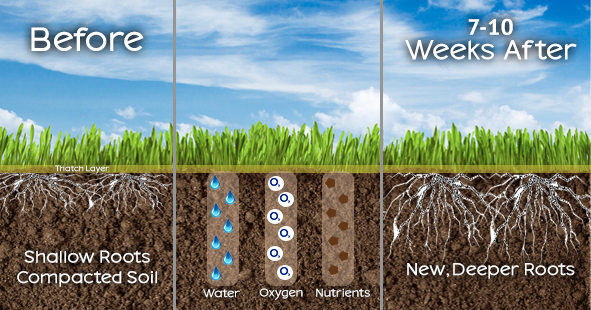What is liquid aeration for lawns? Aeration implies the introduction of air into the lawn, which is partially correct. Aeration is the process of letting air and water into the soil, which makes the soil less dense. The lawn is very important for homeowners as it offers one’s family a great walking surface. Regular aeration makes your lawn healthy and evergreen.
Aeration is a vital part of your lawn care for longer-lasting improvement in the quality of your lawn. In this article, we are going to discuss the different types of lawn aeration, which aeration has more benefits, and all about liquid aeration.
What is the purpose of aeration?
The purpose of aeration is to prepare lawns for the upcoming season. It makes your lawn soil loosen and facilitates it to conserve more air, water, and nutrient supply as well. Usually, aeration is done in the fall, which helps your lawn be ready for the winter.

Your lawn has a coating of thatch that remains undigested close to the soil surface where root systems and stems grow. This undecomposed layer creates a barrier for air and water flow to the surface. Aeration gives your lawn space for air, sunlight, and water, which affects making the thatch decompose. It has too many benefits, including
- Aesthetics purpose:
Aeration is done for aesthetic purposes. It makes your lawn soil loose and helps to strengthen your lawn’s root system through a proper supply of water, air, and sunlight. By investing in aeration, you can impress your family, friends, and neighbors as well.
- Longevity of lawn:
If you do the right kind of aeration at the right time, you can strengthen your lawn grass and make it last longer. By aerating the lawn at the right times, the grass gets the right amount of nutrients.
- Improve overall health:
Your lawn grass will become healthier than before and offer you a green and lush appearance. If you want to keep your lawn healthy for years, it is vital to practice aeration in time.
What is core aeration?
The process of “core aeration” involves using an aerator machine to break up the heavy clay soils and make them more permeable to nutrients, water, air, and fertilizer. The principal goals of this strategy are to lessen soil compaction and eliminate excessive thatch. The air-soil relationship is also enhanced through core aeration. The tiny soil plugs and some thatch are lifted from the ground using an aerator machine.
What is liquid aeration for lawns?
Liquid aeration is a method of aeration that uses organic materials to help water and air get into the soil and prevent thatch from building up on the lawn’s surface. On the grass, where no aeration machine is present and no soil plugs are being removed, liquid aeration is used. This technique is used to boost the oxygen levels in the soil for the grassroots.
Comparison of core aeration and liquid aeration:
| Core aeration | Liquid aeration |
| Core aeration is a practice of lawn care where plugs of soil are pulled out from the ground by a machine such as a soil aerator. | Liquid aeration is a technique of practicing aeration with a natural solution. |
| It is a physical way of making space that provides an instant supply of air, water, and nutrients as well as allows them to reach the soil so that grass can grow. | You can simply apply a diluted liquid solution including added nutrients to the soil to loosen it without using an aerator machine. |
| The core aerator makes it easier for soil to breathe and reduces the amount of thatch buildup. | The liquid solution helps your lawn soil by loosening up and decomposing the soil’s thick particles like dead roots and thatch. |
| Many lawn owners usually practice core aeration for immediate relief from compact problems of soil. | This is a simple application technique that can loosen the soil considerably more deeply than core aeration. |
| Although the effects of core aeration are apparent very quickly, their impact is short-lived. | Liquid aeration has fewer immediate effects but ones that last longer and improve your soil’s conditions over time. |

How do you observe compacted earth?

It is pretty easy to observe when your soil is compacted. It just takes some effort to notice the behavior of your lawn. You can tell if your soil is dense by looking for a few common signs. Here are some typical signs;
- Surface run-off of the water from the higher regions.
- Accumulation of water in the lower regions.
- Sparse and spotted grass.
- Trees have little roots.
- Both weeds and grass cannot thrive in bare places.
- Because of the rough dirt, shoveling is challenging.
How can you deal with highly compacted lawn soil?
It is advised to use both liquid and core aeration when the soil in the lawn is severely compacted. Liquid aeration penetrates deeper into the soil after core aeration creates a hole in it for a longer-lasting remedy against compaction and thatch decomposition. By allowing liquid aeration to infiltrate the lawn through core aeration, its action operates better and more swiftly.
What makes liquid aeration necessary?
The grass needs liquid aeration for the following reasons:
- To remove soil compaction.
- Utilizing irrigation or rain to drain out or penetrate the excess water.
- The removal and decomposition of thatch.
- To increase the oxygen levels of soil.
- To create a lawn that is healthy, robust, and evergreen.
How do you choose a liquid lawn aerator?
When you tend to purchase and use a liquid lawn aerator, there are some things to consider before selecting a liquid lawn aerator.
1. Ingredients Quality:
The quality of the ingredients should be your primary concern when buying a liquid lawn aerator. Purchasing substances that are toxic to soil or elements of nature should always be avoided. You must choose ingredients that can assist the good microbes that can encourage natural aeration.
2. Effectiveness of the products:
The efficiency of the substances is a key consideration when choosing a liquid aerator. It is possible that looking good in the pack does not necessarily translate into good performance. The effectiveness of the product for a particular lawn and environment can be determined by analyzing the customer reviews posted online.
3. Use sustainable ingredients:
You must get environmentally friendly ingredients that are also safe for your grass. Make use of biodegradable substances to prevent any negative effects on the environment.
When should you apply liquid aeration?
Liquid aeration is typically carried out to prepare your grass for winter. The optimal seasons for performing it are spring and fall, similar to core aeration. It’s time to aerate liquids when the temperature ranges between 50 and 90 °F. Applying this at 1.5 to 2 months intervals is the best timing. Avoid applying it when the temperature falls below 50 °F.
Is liquid aeration eco-friendly?
The fact that liquid aeration is ecologically friendly is one of its most significant features. The treatment method used here is entirely organic. This is a combination of two different natural ingredients that will appropriately aerate your lawn. A wetting agent is one kind and it’s helped to make it possible for water to permeate clay soils that are very tightly compacted. Another is the microbes responsible for eliminating and decomposing the thatch layer.
How to use a liquid aerator?
We all know about the effectiveness of liquid aeration. But, it is a matter of fact, how to use a liquid aerator. Here are some of the easy steps to working on liquid aeration.
Step- 1: Calculate the area of your lawn in square feet:
Measure the size of your lawn and mark it into rectangular parts. Following that, multiply the rectangle’s length by its breadth by the length and width that you measured. Feet units are used to measure every dimension. For each part, you will get square feet of units. For finding the total area, add all the rectangular units.
Step- 2: Find out how compacted your lawn is:
You must first determine whether your soil is compacted or not. Lawn grass takes much of its air from underneath the ground than above ground. A suffocating condition for the roots may result from excessive soil compaction. In compact soil, the availability of free oxygen is less.
Step- 3: Choose the sprayer type and capacity that you intend to utilize:
You have to choose the right aerator for application based on the sprayer you want to use. Find out the sprayer’s capacity to determine how much liquid you can spray at once.
Step- 4: Find out how many square feet you can cover with that amount of liquid:
The next step is to determine the area in which you spray the liquid aerator. You have to determine it by measuring with a foot unit.
Step- 5: Calculate the quantity of product you should spray on your grass:
Finally, determine how much aerator is required for the specific area that you wish to aerate. For this, you need to know the scale of using a liquid aerator.
The scale of using a liquid aerator:
A liquid aerator should be thoroughly shaken with water before use. The scale of using it is given below-
- For healthy soil: 2 oz/1000 sq ft.
- For moderately compacted soil: 4 oz/1000 sq ft.
- For extremely compacted soil: 8 oz/1000 sq ft.
Final Thoughts:
Your lawn becomes healthy and evergreen after receiving aeration treatment from the liquid aerator. This one is one of the easiest aeration techniques. It not only saves you money, but it can also save you a lot of time and effort. When you observe that your lawn grass appears weird due to compaction, you can utilize it all year round.



